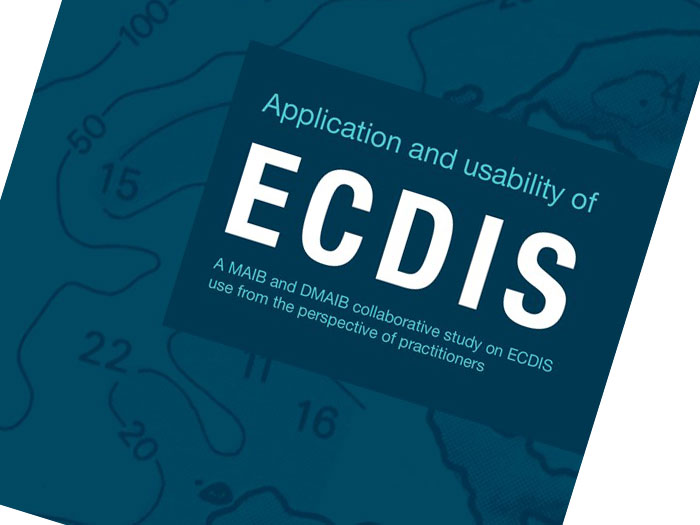
ECDIS: Still a work in progress?
Written by Marine Log Staff
The U.K. and Danish marine accident investigation agencies have published the finding of a long running study of ECDIS (Electronic Chart Display and Information Systems) prompted by their investigations of groundings since 2008 in which ECDIS system were the primary means of navigation.
“Despite being in service for nearly two decades ECDIS could, at best, be described as being in its implementation phase,” said Oessur Hilduberg, Head of the DMAIB and Andrew Moll, Chief Inspector of Marine Accidents, MAIB, in a joint statement released along with the page study. “Specifically, most of the automated functions designed to alert the watchkeeper to impending dangers were not easy to use and lacked the granularity for navigation in pilotage waters.”
The study was undertaken after MAIB and DMAIB identified a mismatch between the way ECDIS was used and the intention of performance standards and system design. This prompted the agencies to study ECDIS use from the perspective of practitioners. The aim was to generate an understanding of the practical application and usability of ECDIS and support future ECDIS design, training strategies and the development of best practices. The study followed a qualitative methodology, primarily based on semi-structured interviews with 155 ECDIS users and observation data gathered between February and July 2018 during sea voyages in European waters on 31 ships of various types.
The following is taken from the executive summary of the study:
FINDINGS
Spectrum of use
ECDIS use was contextual across a wide spectrum with practices dependent on type of ship, ship trade and area of operation. This included ECDIS status (primary means of navigation, back-up or navigation aid); ECDIS type (model/number/age) and level of integration with other equipment; bridge layout and ergonomics; user familiarity and knowledge of the system; user experience; bridge manning and organization; on board procedures; trading patterns; masters’ preferences and level of exposure to port state control, vetting and audit.
At one end of the spectrum of ECDIS use were paperless ships with a high level of bridge system integration with purpose designed “cockpit-style bridge layouts, multiple ECDIS and multi-function displays (MFD) integrated with sensors and systems via a data highway. At the other end of the spectrum of ECDIS use were ships with a stand-alone ECDIS.
Within the spectrum of ECDIS use, some ships continued to carry paper charts in addition to ECDIS, increasing the navigators’ workload as both media required correction/updating. In some cases, passage plans had to be drawn on the charts as well as input to the ECDIS. Where paper charts were the primary means of navigation, and ECDIS was a “navigation aid” or for “training purposes only,” ECDIS was used as the principal tool for navigation, but its safety features, such as the lookahead, were often ignored. In effect, paper chart use was a compliance activity, limited to the periodic plotting of positions “for the record,”
Overall benefits
Users identified the ECDIS’ main contributions to safe navigation as the reduction in workload and the increase in situational awareness resulting from real-time positioning. ECDIS’ reliability and the integration of ECDIS with other navigational systems were also seen as benefits. Given that the various sources of information are usually accurate, and the users rarely experienced malfunctions, they were generally found to trust the information provided by ECDIS and its technical reliability. Some ECDIS functionalities were seen to reduce the manual labor of updating charts, plotting routes using waypoints, etc., but these functionalities were not necessarily viewed as contributing to safe navigation per se.
Noticeably, the users who had experience working with paper charts specifically pointed to the reduction of workload of manually plotting the ship’s position as the main advantage of the ECDIS, because it freed up time to focus on other safety critical tasks, e.g. route monitoring and collision avoidance. A majority of users found this functionality to be the most beneficial system functionality of the ECDIS, because of the time saved. Presumably, the time gained is used for improvement of the cognitive assessment of the navigational situation, i.e. more time for route monitoring, keeping lookout, analyzing the traffic situation, verifying the position by other means, interacting with the pilot, etc. Thereby, the user can make more informed decisions about collision avoidance, maneuvering the ship, etc. From the user perspective, having more time to assess the navigational situation thus becomes the ECDIS’ main contribution to safe navigation.
Challenges
This study showed that while the standardization and allocation of simple and repetitive tasks (plotting the ship’s position and chart update) has brought about tangible benefits, the required user interaction with ECDIS has introduced challenges that cut across system design, practices and training. These challenges include:
- The distraction of alerts and alarms, particularly during pilotage, that leads to coping strategies ranging between alarm “normalization” and physical disablement.
- The frequent impracticality of the setting of an efficient safety contour, leading to the use of ‘official workarounds’ (e.g. included in recognized guidance) and “unofficial workarounds” (e.g. alarm disablement) to optimize the display to make the best of a bad job. Alternatively, the safety contour is ignored altogether.
- The number and types of alerts generated during automatic route checks that leads to them either being ignored or increases the risk of planners missing safety critical alerts among numerous more trivial ones.
- Interfaces and menu complexity that increase cognitive workload, particularly in busy environments, which results in users focusing on ECDIS to the detriment of other sources of information.
- The difficulty of residual manual tasks such as planning radar parallel indices, plotting limiting danger lines or writing text notes, which are often time-consuming, deters users from their application.
- ECDIS requires significant cognitive resources to use its functions, which has contributed to a minimalist approach by users.
- ECDIS use continues to be framed and audited within the context of paper chart practices with Flag State, PSC and SIRE inspections often not recognizing new ways of working such as the use of radar information overlay to verify position.
- Users are trained to distrust the ECDIS and continuously verify the ship’s position by alternative means. However, significant discrepancies are rarely encountered.
CONCLUSION
From a user perspective, ECDIS does contribute to safe navigation, but the challenges that have accompanied its introduction are problematic. Some of these challenges stem from the system’s automation not always working efficiently due either to the lack of bathymetric fidelity i.e the provision of depth contours in the same manner as provided on paper charts and/or human-centred design not being considered. Decisions to automate and “alarm” the safety contour seem to have been based on the technical ability to do so rather than on an adaptable blending of human and machine capabilities to complete identified tasks in differing scenarios and environments.




